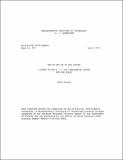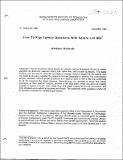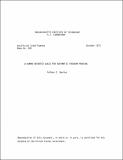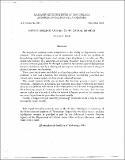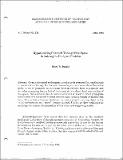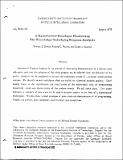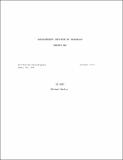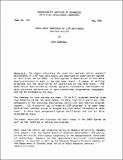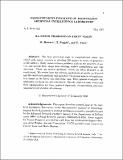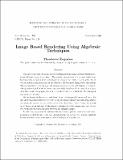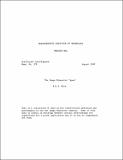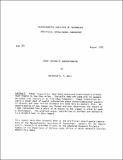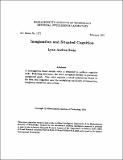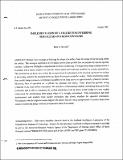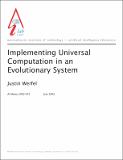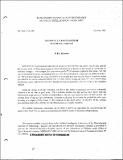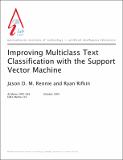Browsing AI Memos (1959 - 2004) by Title
Now showing items 458-477 of 1217
-
How to Get onto the System
(1971-04-01)This memo is intended to get very new users started on the MAC AI system. It presents some simple rituals for making and editing fields, getting print outs, making microtapes, and so on. Most of the rituals given are not ... -
How to Play Twenty Questions with Nature and Win
(1982-12-01)The 20 Questions Game played by children has an impressive record of rapidly guessing an arbitrarily selected object with rather few, well-chosen questions. This same strategy can be used to drive the perceptual process, ... -
A Human Oriented Logic for Automatic Theorem Proving
(1972-10-01)The automation of first order logic has received comparatively little attention from researcher intent upon synthesizing the theorem proving mechanism used by humans. The dominant point of view [15], [18] has been that ... -
Hypergeometric Functions in MATHLAB
(1970-06-01)This memo describers some of the important properties and manipulations of Hypergeometric Functions which my be useful in MATHLAB. A convention for representing the function is adopted which is readily adaptable to ... -
Hypothesizing and Refining Causal Models
(1984-12-01)An important common sense competence is the ability to hypothesize causal relations. This paper presents a set of constraints which make the problem of formulating causal hypotheses about simple physical systems a ... -
Hypothesizing Channels through Free-Space in Solving the Findpath Problem
(1983-06-01)Given a polyhedral environment, a technique is presented for hypothesizing a channel volume through the free space containing a class of successful collision-free paths. A set of geometric constructions between obstacle ... -
A Hypothetical Monologue Illustrating the Knowledge Underlying Program Analysis
(1979-01-01)Automated Program Analysis is the process of discovering decompositions of a system into sub-units such that the behavior of the whole program can be inferred from the behavior of its parts. Analysis can be employed ... -
I/O Test
(1967-10-01)IO TEST is intended as a hardware testing and debugging aid for use with the PDP-6 and its associated input multiplexer (analog to digital converter) and output multiplexer (digital to analog converter). While all characters ... -
Ideas About Management of LISP Data Bases
(1975-05-01)The paper advocates the need for systems which support maintenance of LISP-type data bases, and describes an experimental system of this kind, call DABA. In this system, a description of the data base's structure is ... -
Ill-Posed Problems and Regularization Analysis in Early Vision
(1984-04-01)One of the best definitions of early vision is that it is inverse optics --- a set of computational problems that both machines and biological organisms have to solve. While in classical optics the problem is to determine ... -
Ill-Posed Problems in Early Vision
(1987-05-01)The first processing stage in computational vision, also called early vision, consists in decoding 2D images in terms of properties of 3D surfaces. Early vision includes problems such as the recovery of motion and ... -
Image Based Rendering Using Algebraic Techniques
(1996-11-01)This paper presents an image-based rendering system using algebraic relations between different views of an object. The system uses pictures of an object taken from known positions. Given three such images it can ... -
The Image Dissector "Eyes"
(1969-08-01)This is a collection of data on the construction operation and performance of the two image dissector cameras. Some of this data is useful in deciding whether certain shortcomings are significant for a given application ... -
Image Intensity Understanding
(1975-08-01)Image intensities have been processed traditionally without much regard to how they arise. Typically they are used only to segment an image into regions or to find edge-fragments. Image intensities do carry a great ... -
Image-Based View Synthesis
(1997-01-01)We present a new method for rendering novel images of flexible 3D objects from a small number of example images in correspondence. The strength of the method is the ability to synthesize images whose viewing position ... -
Imagination and Situated Cognition
(1991-02-01)A subsumption-based mobile robot is extended to perform cognitive tasks. Following directions, the robot navigates directly to previously unexplored goals. This robot exploits a novel architecture based on the idea ... -
Implementation of a Theory for Inferring Surface Shape from Contours
(1982-08-01)Human vision is adept at inferring the shape of a surface from the image of curves lying across the surface. The strongest impression of 3-D shape derives from parallel (but not necessarily equally spaced) contours. ... -
Implementing Universal Computation in an Evolutionary System
(2002-07-01)Evolutionary algorithms are a common tool in engineering and in the study of natural evolution. Here we take their use in a new direction by showing how they can be made to implement a universal computer. We consider ... -
The Implicit Constraints of the Primal Sketch
(1981-10-01)Computational theories of structure-from-motion and stereo vision only specify the computation of three-dimensional surface information at points in the image at which the irradiance changes. Yet, the visual perception ... -
Improving Multiclass Text Classification with the Support Vector Machine
(2001-10-16)We compare Naive Bayes and Support Vector Machines on the task of multiclass text classification. Using a variety of approaches to combine the underlying binary classifiers, we find that SVMs substantially outperform Naive ...
